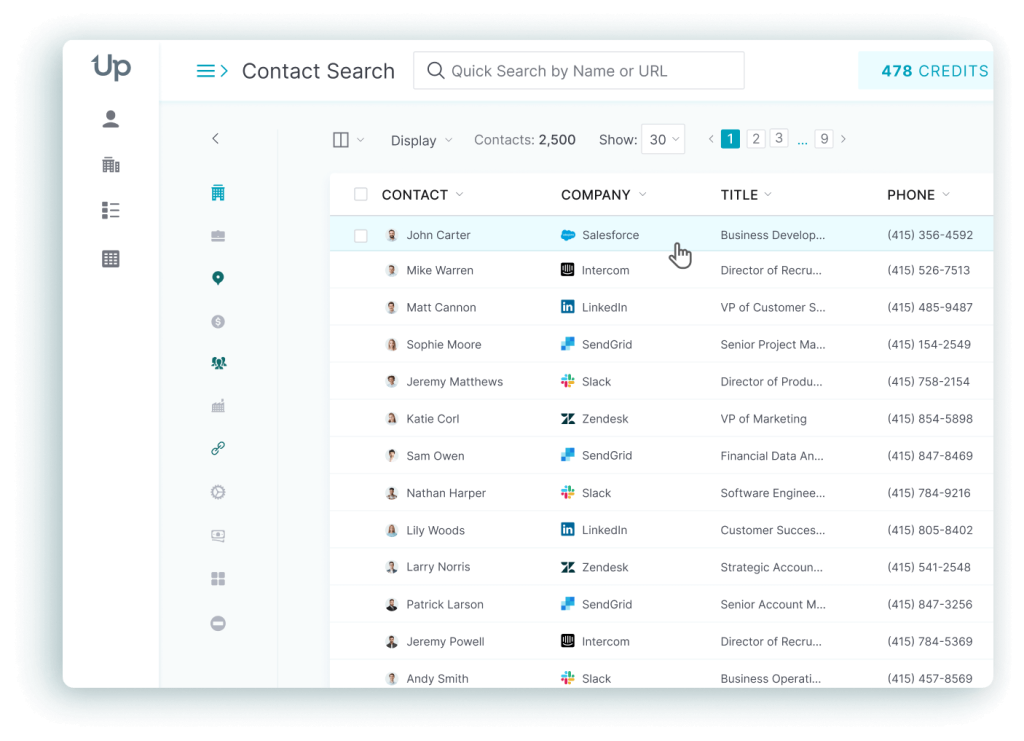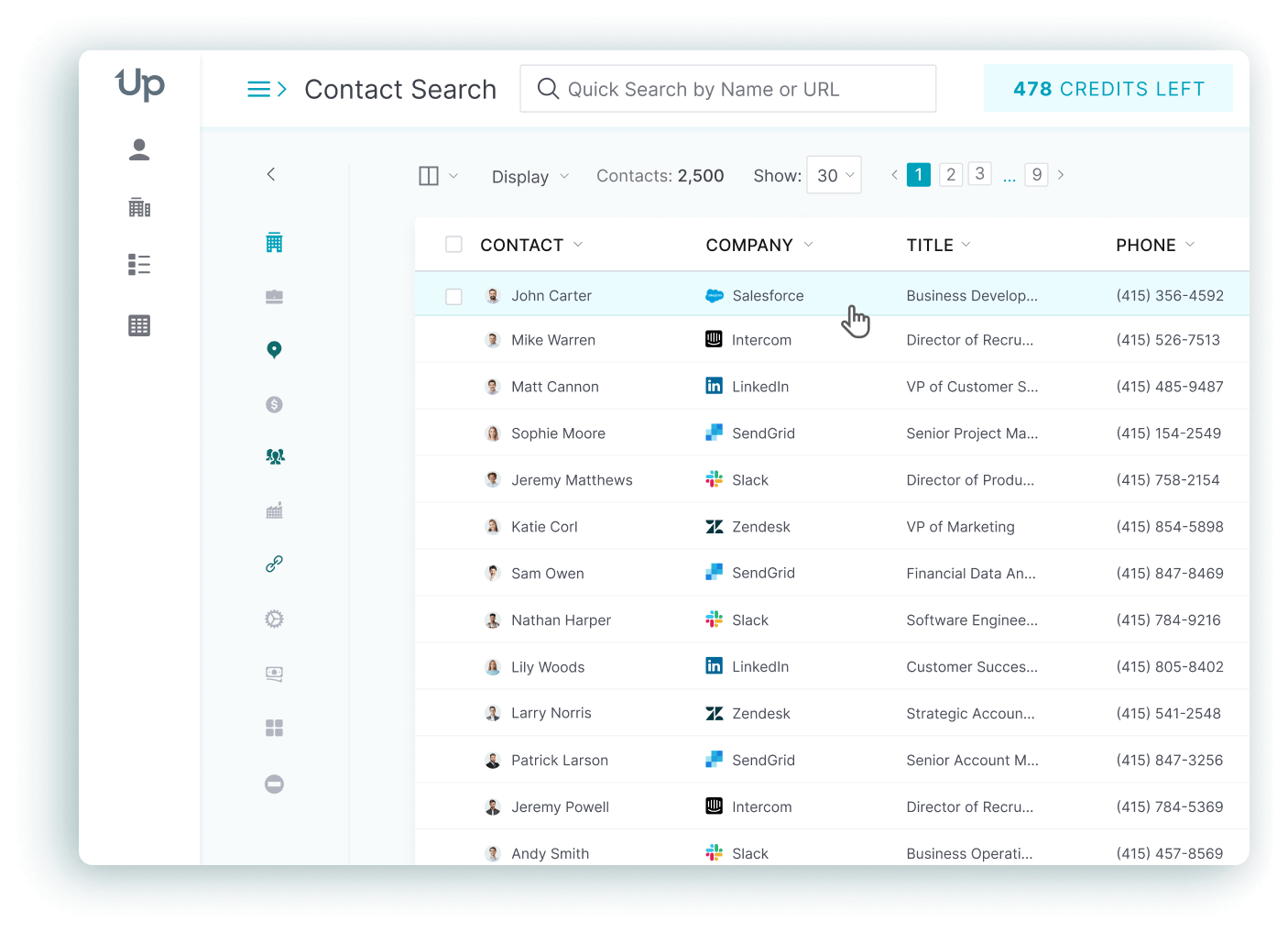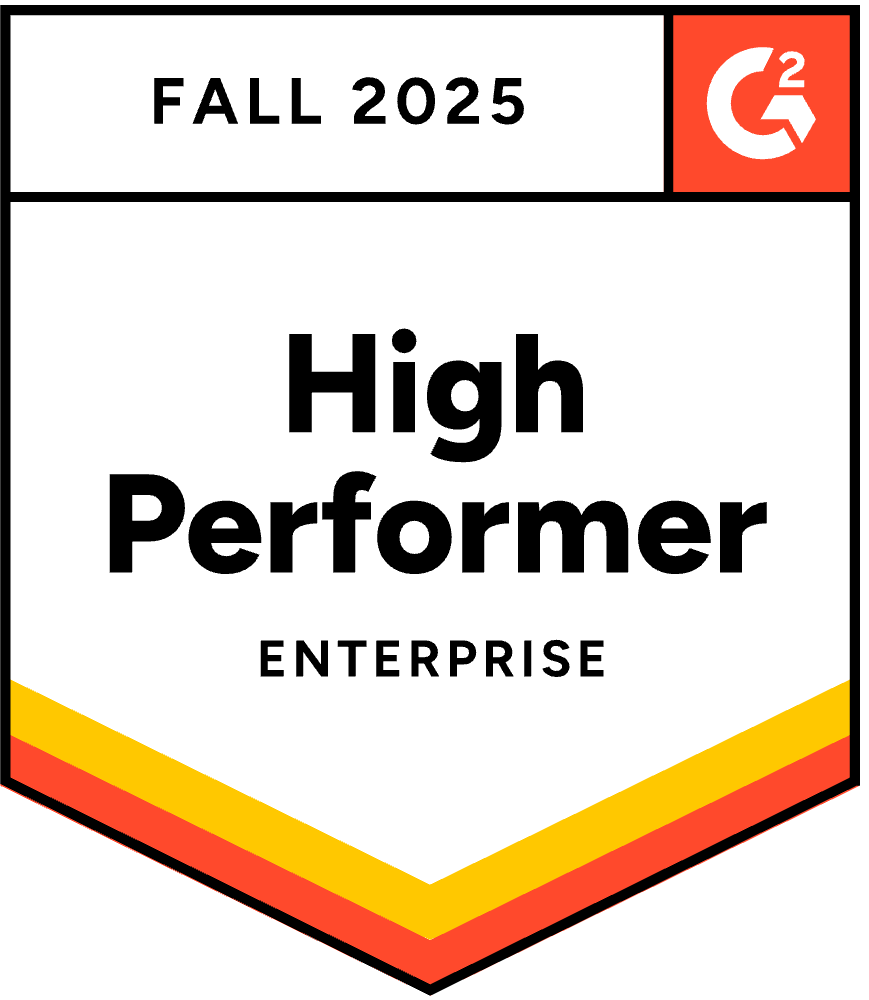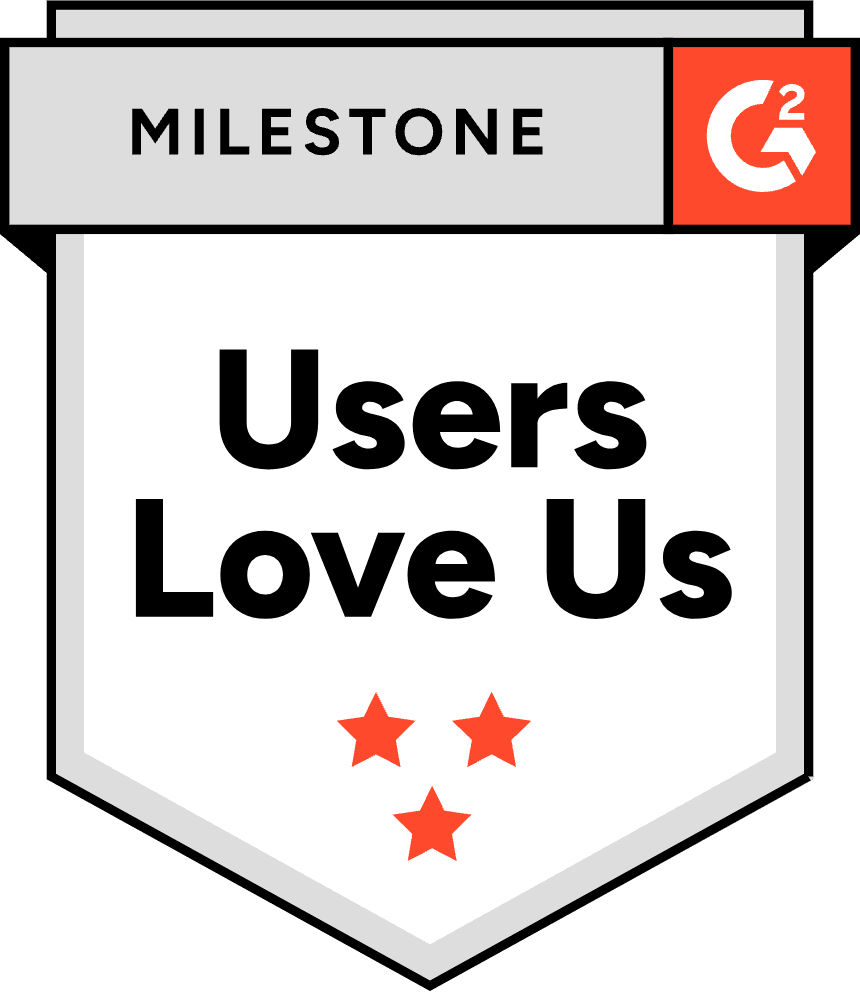Picture this: Your best sales rep just told you they’re spending 70% of their day on administrative tasks instead of selling. Sound familiar? According to the 6th Edition of the Salesforce ‘State of Sales’ report, sales reps spend only about 30% of their time on actual selling activities.
As the founder of UpLead, I’ve witnessed this inefficiency firsthand across hundreds of sales teams. It’s not just a productivity drain, it’s a recipe for disaster that leads to missed quotas, frustrated leadership, and talented reps burning out as they drown in data entry instead of building relationships and generating revenue.
But what if you could reclaim those lost hours? The same Salesforce report found that 83% of sales teams using AI saw revenue growth last year, proving that the right tools are a critical differentiator. From my experience building UpLead and working with thousands of sales professionals, I can confidently say that the right sales productivity platform can transform a struggling team into a revenue-generating machine. This comprehensive guide shows you exactly how to automate repetitive tasks, streamline your workflow, and empower your team to focus on what they do best: selling.
What Are the Best Sales Productivity Tools?
The best sales productivity tools based on our experience are:
| Category | Our Top Pick | Why We Recommend It |
|---|---|---|
| Sales Intelligence & Data Enrichment | UpLead | 95% email accuracy with real-time verification and 160M+ verified contacts |
| CRM & Pipeline Management | HubSpot Sales Hub | Comprehensive free tier with powerful sales automation features |
| Sales Engagement & Outreach | Outreach | AI-powered sales execution platform for complex sales processes |
| Conversation Intelligence | Gong.io | Market-leading AI insights for conversation analysis and coaching |
| Email Optimization | Lavender | Real-time email coaching to improve response rates |
| Scheduling & Meeting Automation | Calendly | Simple, effective scheduling with excellent integrations |
| Video Conferencing | Zoom | Reliable, feature-rich platform with recording capabilities |
| Communication & Dialers | Aircall | Cloud-based phone system with comprehensive CRM integration |
| Proposal & eSignature | PandaDoc | Complete document automation with analytics and templates |
| Sales Enablement | Highspot | Comprehensive content management with advanced coaching tools |
| Productivity & Time Management | TMetric | Detailed time tracking with productivity analysis |
What Are Sales Productivity Tools?
As the founder of UpLead, I’ve seen firsthand how the right sales productivity software can transform a struggling sales team into a revenue-generating machine. Sales productivity tools are software applications and platforms designed to make sales teams more efficient and effective. Their primary purpose is to automate repetitive, time-consuming administrative tasks, streamline processes, and provide data-driven insights, which allows sales representatives to spend more time on high-value activities like building client relationships and closing deals.
These tools cover every aspect of the sales process and typically include functionalities such as Customer Relationship Management (CRM) for managing customer data, sales automation for tasks like email follow-ups, sales intelligence for gathering prospect data, and analytics to track performance. By centralizing information and reducing manual operations, these tools help accelerate the sales cycle and boost overall performance.
Why Are Sales Productivity Tools Essential for Modern Sales Teams?
Adopting inside sales productivity tools offers numerous benefits that are essential for modern sales teams aiming to increase revenue and gain a competitive edge. Key benefits include:
- Increased Efficiency and Time Savings: These tools automate repetitive tasks such as data entry, scheduling, and follow-up emails, freeing up valuable selling time.
- Shorter Sales Cycles: By streamlining workflows and automating communications, teams can engage leads faster and more consistently, reducing the time from first contact to close.
- Improved Sales Forecasting and Data-Driven Decisions: Sales analytics tools provide real-time insights into performance, track key metrics, and identify trends that inform strategic decisions.
- Enhanced Customer Relationships: With centralized customer data in a CRM, reps can access a complete history of interactions, enabling more personalized and timely communication.
- Increased Revenue and Profitability: By improving efficiency, shortening the sales cycle, and enabling reps to focus on high-value tasks, these tools directly contribute to closing deals and boosting revenue.
- Better Team Collaboration and Morale: These tools often provide a centralized platform for managing sales activities, which improves alignment and collaboration between team members and other departments like marketing.
Key Categories of Sales Productivity Tools
The main categories of sales productivity tools are:
- Customer Relationship Management (CRM): This is the core of most sales tech stacks, acting as a central database for managing all customer interactions, data, and relationships throughout the sales cycle.
- Sales Intelligence & Data Enrichment: These tools gather and analyze data on prospects, customers, and market trends to provide actionable insights. They enrich CRM data with details like company information, decision-maker contacts, and buying signals.
- Sales Engagement & Outreach: These platforms streamline and automate outreach across multiple channels like email, phone, and social media. They help sales reps execute and manage communication sequences at scale.
- Conversation Intelligence & AI Assistants: AI-powered tools that record, transcribe, and analyze sales calls to provide coaching insights and deal intelligence.
- Sales Enablement & Content Management: Platforms that provide content management, training, and coaching to help reps have more effective customer interactions.

The Best Sales Productivity Tools for 2025
I’ve analyzed the market and compiled the most comprehensive list of sales productivity tools available today. Each tool has been evaluated based on core functionality, user reviews, integration capabilities, and AI features.
CRM & Pipeline Management
Customer Relationship Management tools form the foundation of your sales tech stack, organizing customer data and managing your sales pipeline from lead to close.
HubSpot Sales Hub
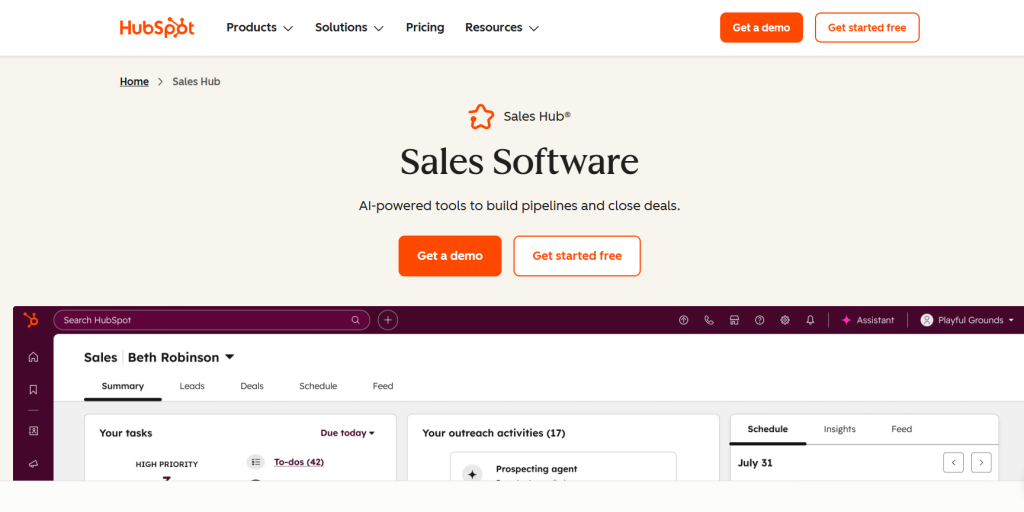
HubSpot Sales Hub is a comprehensive sales software built on a leading CRM platform that combines sales and marketing teams in one integrated ecosystem.
Features:
- Email tracking and meeting scheduler
- Sales automation and pipeline management
- AI-powered conversation intelligence
- Deal management and sales forecasting
- Seamless marketing integration
What I like about HubSpot Sales Hub:
From my perspective as someone who’s built a sales intelligence platform, HubSpot’s approach to unifying sales and marketing data is brilliant. The free tier genuinely provides value not just a limited trial which makes it accessible for startups. I particularly appreciate how their automation workflows can be set up without technical expertise, and the reporting gives you actionable insights rather than just vanity metrics.
Pros:
- Excellent free tier with comprehensive features
- Seamless marketing integration
- User-friendly interface
- Strong automation capabilities
Cons:
- Can become expensive as you scale
- Learning curve for advanced features
- Limited customization on lower tiers
Pricing: Free CRM available. Paid Sales Hub plans start at $20/seat/month
Best for: Small to medium businesses looking for an all-in-one solution with powerful free features
Pipedrive
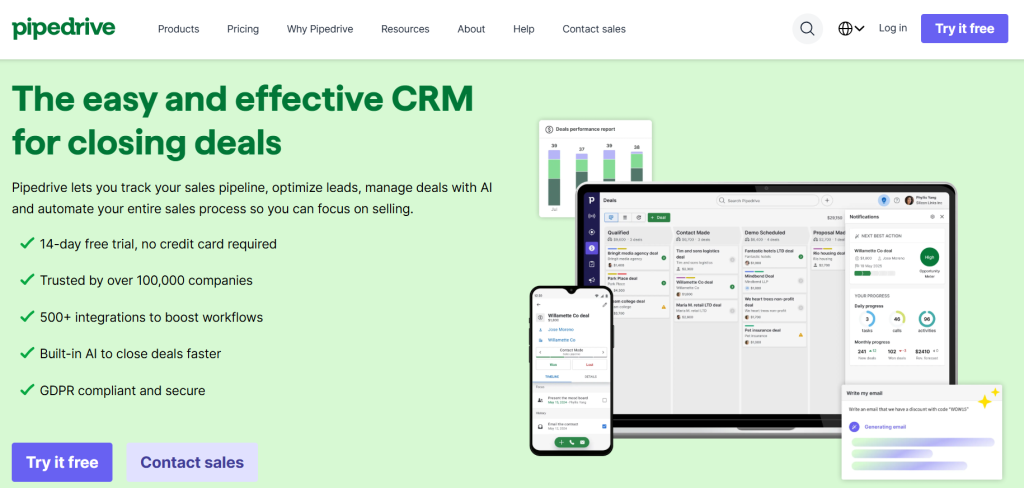
Pipedrive has good features for both sales reporting and forecasting. Apart from PC-based software, it’s available on both iOS and Android. You can easily access it through mobile platforms.
Features:
- Visual pipeline management
- Email integration and activity management
- Sales forecasting and reporting
- Mobile access across platforms
- Deal tracking and automation
What I like about Pipedrive:
Pipedrive’s visual approach to pipeline management is something I’ve always admired. As someone who values data clarity, I appreciate how you can instantly see where deals stand and what actions are needed. The mobile app is genuinely useful not just a stripped-down version of the desktop experience. It’s one of the few CRMs where sales reps actually want to use it rather than being forced to.
Pros:
- Intuitive visual interface
- Strong mobile app
- Easy to set up and use
- Good value for money
Cons:
- Limited customization options
- Fewer advanced features than competitors
- Basic reporting capabilities
Pricing: Plans start at $14.90/user/month
Best for: Small to medium sales teams focused on visual pipeline management
Activity reminders keep you alert about all deals and activities and help sync them with Google Calendar. Moreover, you can edit, complete, and add new actions on the go.
Insightly
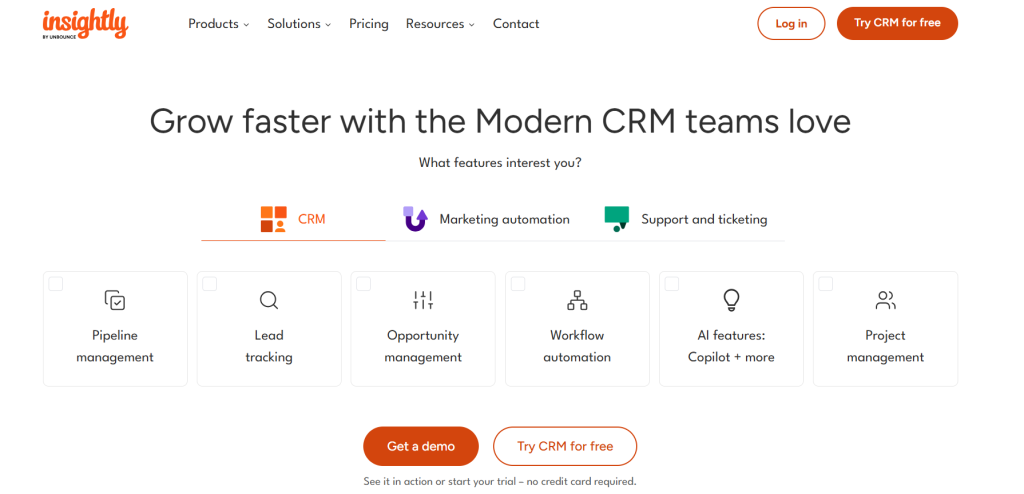
Insightly is a flexible CRM tool that can easily adapt to your business needs. It has a strong relationship-linking feature and routes, leads, automates workflows and emails, keeps records, and streamlines business processes.
Features:
- Relationship linking and lead routing
- Workflow automation and email marketing
- Project management integration
- Custom fields and reporting
- Task and opportunity management
What I like about Insightly:
Insightly’s strength lies in its project management integration something most CRMs treat as an afterthought. For service-based businesses or companies with complex implementation processes, this dual functionality eliminates the need for separate tools. I’ve seen teams use it effectively to track both the sales process and post-sale project delivery, creating a seamless customer experience.
Pros:
- Strong project management features
- Good customization options
- Comprehensive feature set
- Flexible workflow automation
Cons:
- Higher price point
- Can be complex for simple CRM needs
- Steep learning curve
Pricing: Plans start at $29/user/month
Best for: Small businesses needing CRM with project management capabilities
It’s also remotely accessible, and it can deploy custom apps within a matter of minutes.
BIGContacts
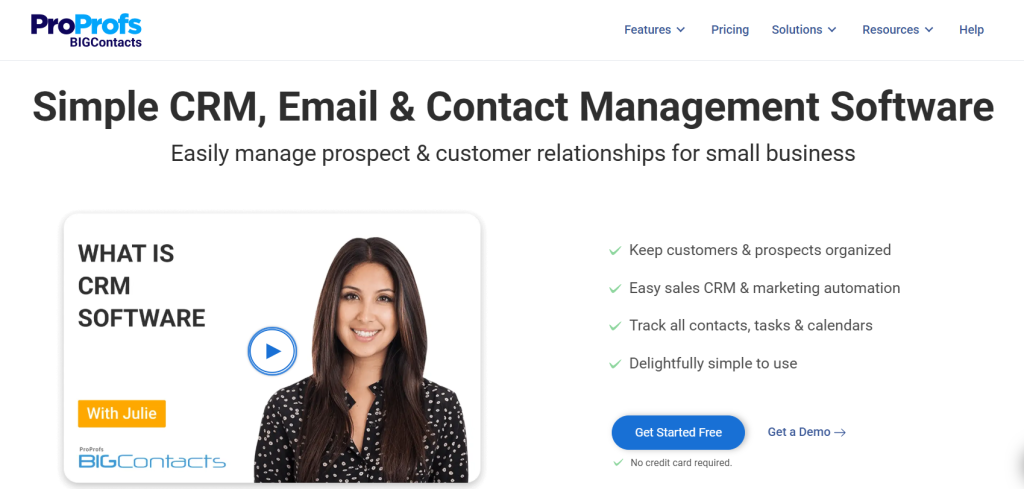
BIGContacts is a powerful CRM tool that can help your sales team work more efficiently. This tool is designed to empower small businesses to manage their customer interactions better, increasing their sales.
Features:
- Contact management and lead tracking
- Sales pipeline tracking and automation
- Email marketing integration
- Team collaboration tools
- Performance reporting and analytics
What I like about BIGContacts:
BIGContacts excels in simplicity without sacrificing functionality. For small businesses that find enterprise CRMs overwhelming, this strikes the right balance. I appreciate their straightforward pricing model no hidden fees or feature restrictions that surprise you later. The customer support is genuinely responsive, which matters when you’re a small team without dedicated IT resources.
Pros:
- Very affordable pricing
- Simple, intuitive interface
- Good customer support
- Easy setup and onboarding
Cons:
- Limited advanced features
- Fewer integrations than larger platforms
- Basic reporting capabilities
Pricing: Plans start at $9.95/user/month
Best for: Small businesses looking for an affordable, simple CRM solution
BIGContacts can help you generate leads, follow up with them on time, and track the performance of your team members with powerful reporting. It also allows you to customize the sales pipeline to keep better track of all available opportunities. Additionally, you can collaborate with team members, streamline your workflow, generate reminders, and automate multiple processes from anywhere with remote access. This, combined with a delightfully simple interface, can significantly boost your team productivity by freeing up the time that goes into performing repetitive tasks.
Sales Intelligence & Data Enrichment
Sales intelligence software helps you find, research, and enrich prospect data to build more targeted outreach campaigns and identify high-value opportunities.
ZoomInfo
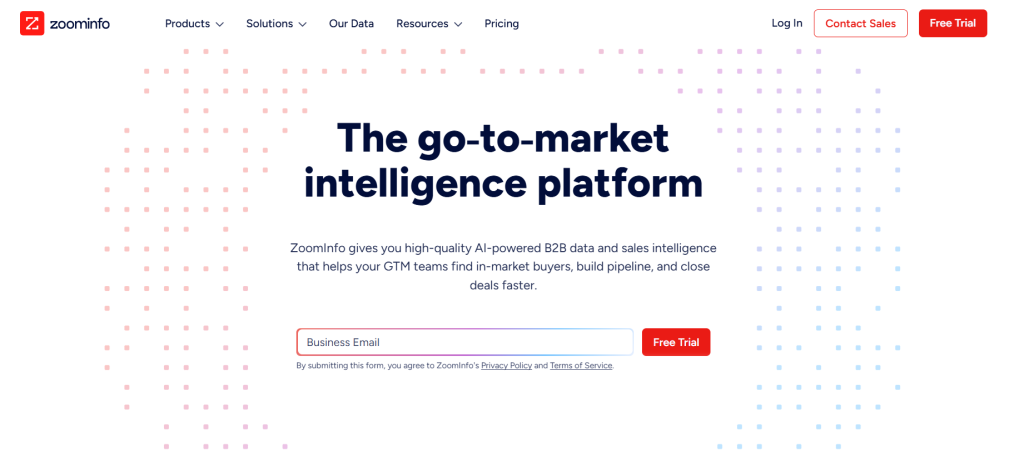
ZoomInfo is a leading B2B intelligence platform providing a massive database of contact and company information with advanced search and intent data capabilities.
Features:
- Comprehensive B2B database with millions of contacts
- Intent data and buying signals
- Data enrichment and lead scoring
- Advanced search filters and segmentation
- CRM integration and workflow automation
What I like about ZoomInfo:
ZoomInfo’s intent data capabilities are genuinely impressive they can identify when companies are actively researching solutions in your space. As someone who understands the value of timing in sales, this intelligence can be game-changing for enterprise teams. Their database coverage is extensive, and the advanced search filters allow for very precise targeting that can significantly improve outreach effectiveness.
Pros:
- Extensive database coverage
- Powerful intent data capabilities
- Strong enterprise features
- Advanced analytics and reporting
Cons:
- Very expensive pricing
- Complex setup and implementation
- May be overkill for small teams
Pricing: Custom pricing, typically starts around $14,000+ annually for teams
Best for: Enterprise and mid-market B2B sales teams with substantial budgets
Apollo.io
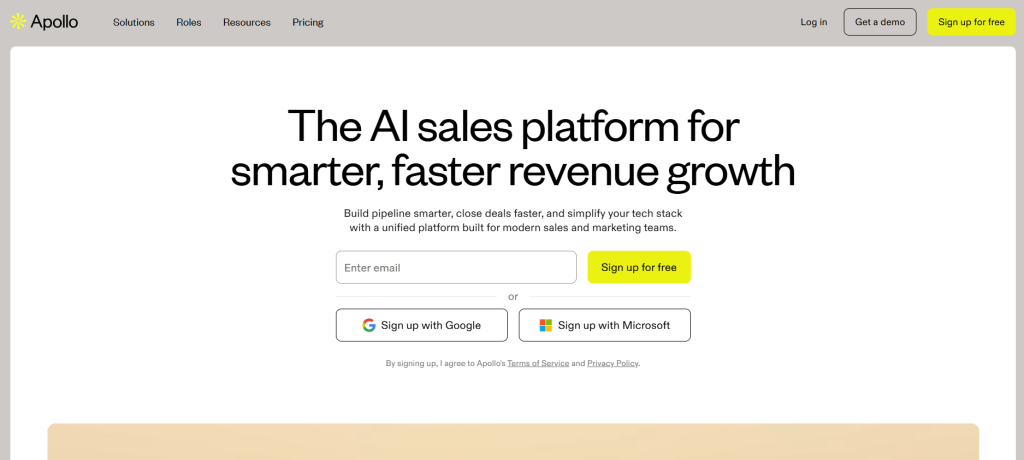
Apollo.io is an all-in-one sales intelligence and engagement platform with a large B2B database that combines prospecting, engagement, and automation in one unified solution.
Features:
- B2B contact database with advanced search
- Email sequencing and automation
- Phone dialer and call tracking
- Analytics and performance reporting
- CRM integration and data sync
What I like about Apollo.io:
Apollo’s all-in-one approach appeals to me because it eliminates the complexity of managing multiple tools. Their free tier is genuinely useful not just a teaser which allows teams to test the platform thoroughly. The combination of prospecting and engagement in one platform creates a smoother workflow, though I’d recommend supplementing with a dedicated email verification tool for critical campaigns.
Pros:
- All-in-one solution for prospecting and engagement
- Competitive pricing with good free tier
- Large database of contacts
- Comprehensive feature set
Cons:
- Data accuracy can vary
- Interface can be overwhelming for new users
- Customer support can be slow
Pricing: Free plan available. Paid plans start at $49/user/month
Best for: SMBs and startups looking for an integrated prospecting and engagement solution
UpLead
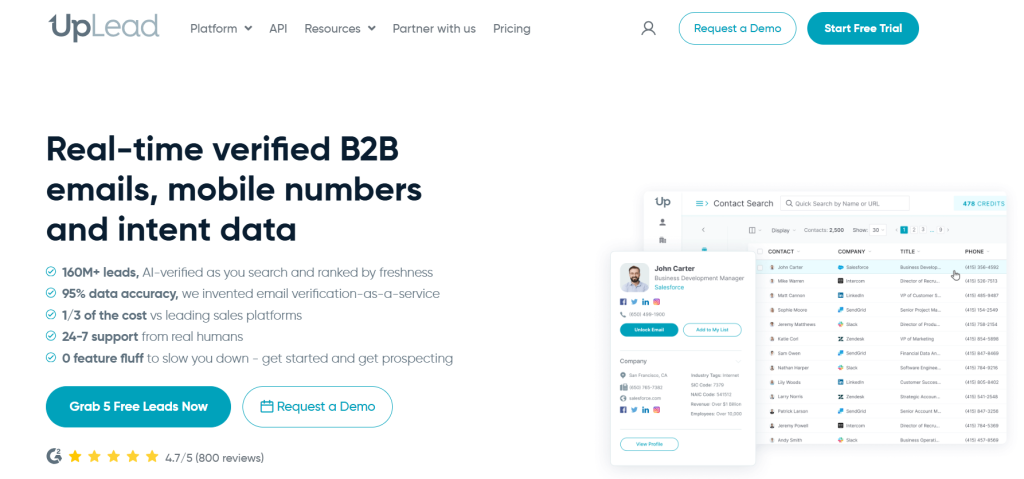
Having built UpLead from the ground up, I can confidently say it ranks among the best sales productivity tool available. UpLead helps drive leads directly to the sales pipeline, automatically segments them, and streamlines activities for each client. Without quality leads, there isn’t any need to implement a sales management platform. UpLead also has an automatic client-profiling system, which saves time when creating a leads list.
Features:
- 160M+ verified contacts with 95% email accuracy
- Real-time email verification technology
- 50+ search filters for precise targeting
- Intent data and buying signals
- CRM integration and data export
What I like about UpLead:
As the founder, I’m obviously biased, but I built UpLead to solve the exact problems I experienced as a sales professional. The 95% email accuracy rate isn’t just a marketing claim it’s the result of our real-time verification technology that checks emails at the moment of download. I’m particularly proud of our customer success approach; we don’t just sell you data, we help you use it effectively to drive revenue.
Pros:
- Industry-leading 95% email accuracy
- Real-time verification prevents bounces
- Excellent customer support and onboarding
- Transparent credit-based pricing
- Advanced search and filtering capabilities
Cons:
- Credit-based pricing model
- Smaller database than some enterprise competitors
- Limited social media data
Pricing: Plans start at $74/month for 1,000 credits
Best for: B2B sales teams needing verified contact data with real-time email verification
UpLead specializes in lead generation and offers businesses a free trial before they change their entire sales management process.
If you want to compare UpLead against its strongest competitors, check out our UpLead alternatives guide.
LinkedIn Sales Navigator
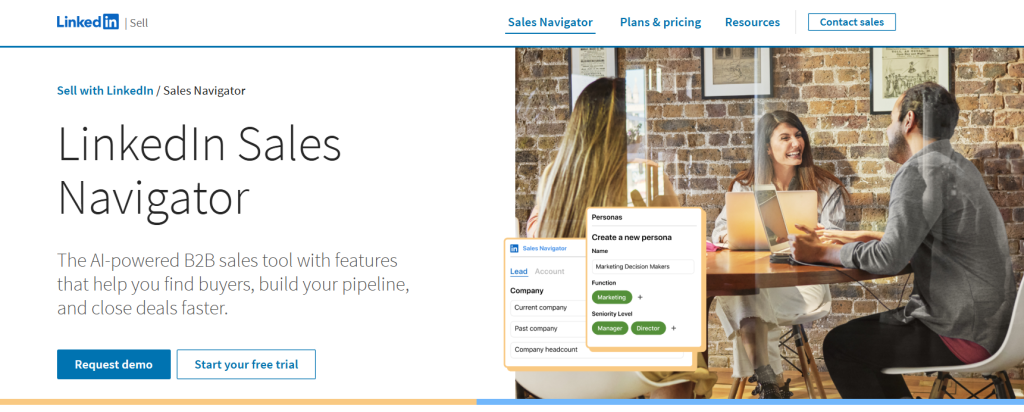
LinkedIn Sales Navigator is an advanced sales tool. Advanced filters enable users to reach their desired leads in the search feature. This application is also ideal for B2B sales, providing actionable insights and a deeper understanding of prospective leads.
Features:
- Advanced LinkedIn search filters
- InMail messaging and outreach
- Lead recommendations and alerts
- CRM integration and data sync
- Sales insights and team collaboration
What I like about LinkedIn Sales Navigator:
LinkedIn Sales Navigator excels at relationship-based selling, which is crucial in B2B sales. The ability to see mutual connections and get warm introductions can significantly improve response rates. I particularly value the real-time updates about prospects knowing when someone changes jobs or posts about industry challenges gives you perfect conversation starters. It’s essential for social selling strategies.
Pros:
- Access to LinkedIn’s professional network
- Strong social selling features
- Real-time prospect updates
- Excellent for relationship building
Cons:
- Limited to LinkedIn ecosystem
- Can be expensive for large teams
- InMail credits are limited
Pricing: Plans start at $79.99/month
Best for: B2B sales professionals focused on social selling and relationship building
In LinkedIn’s search feature, users can reach their desired customers through advanced filter features, and the application provides actionable insights that offer a deeper understanding of leads.
By offering customized and personalized content and offers through the InMail feature, users can engage with prospective leads in a personalized way. By using Sales Navigator, prospective clients can be easily approached on Linkedin without having to connect.
Clearbit (now part of HubSpot)
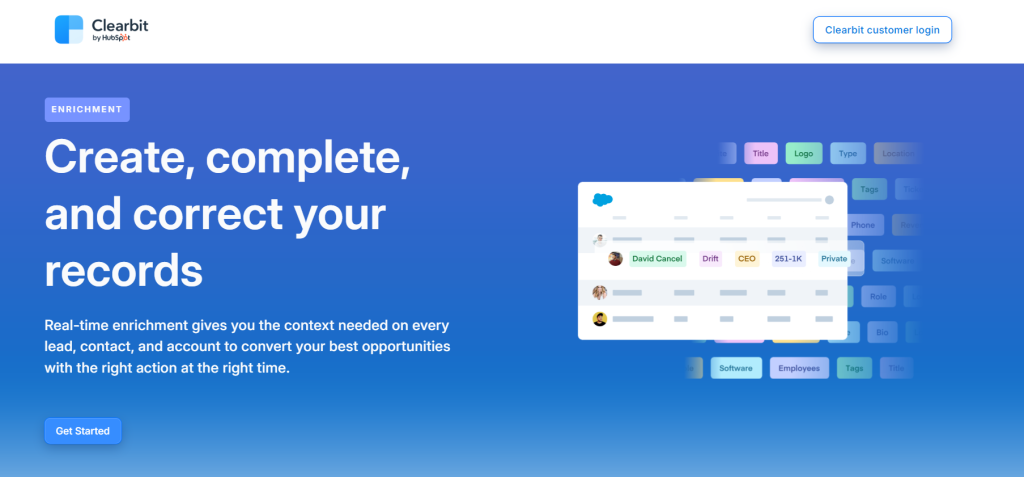
Clearbit helps enrich lead data by automating records and workflows by shortening signup forms and improving lead scoring. Clearbit works on real-time data. It instantly adds accurate contact details of your leads to CRM records, so your business will have this information when needed.
Features:
- Real-time data enrichment
- Form shortening and lead capture
- Lead scoring enhancement
- CRM integration and automation
- Company and contact data
What I like about Clearbit:
Clearbit’s real-time enrichment capability is impressive the moment someone fills out a form, you instantly get their complete profile. This immediate context allows sales reps to have much more informed conversations. Since the HubSpot acquisition, the integration has become seamless, making it a powerful addition to the HubSpot ecosystem for teams already using that platform.
Pros:
- Seamless HubSpot integration
- High-quality data sources
- Real-time enrichment capabilities
- Improves lead qualification
Cons:
- Limited to HubSpot ecosystem post-acquisition
- Can be expensive for high-volume usage
- Requires technical setup
Pricing: Now integrated with HubSpot pricing plans
Best for: HubSpot users looking for enhanced data enrichment capabilities
Clearbit sources data from over 250 verified public and private sources that are verified for accuracy through stringent quality-assurance processes.
Sales Engagement & Outreach
Sales engagement platforms help you execute multi-channel outreach campaigns, automate follow-ups, and track engagement metrics across your entire sales process.
Outreach
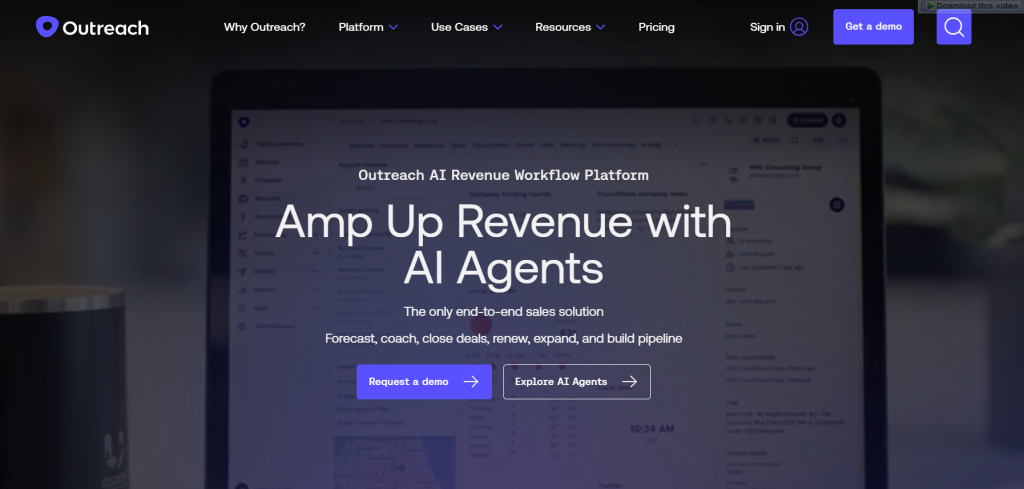
Outreach is an AI-powered sales execution platform designed to manage the full revenue cycle, from prospecting to forecasting, with advanced automation and analytics.
Features:
- Automated sequences and multi-channel outreach
- AI-powered insights (Kaia) for deal intelligence
- Deal management and pipeline tracking
- Conversation intelligence and call analysis
- Advanced analytics and revenue forecasting
What I like about Outreach:
Outreach’s AI capabilities, particularly their Kaia assistant, represent the future of sales technology. The platform’s ability to analyze patterns across your entire sales organization and provide actionable recommendations is impressive. For enterprise teams with complex sales processes, the level of automation and intelligence Outreach provides can significantly impact productivity and deal outcomes.
Pros:
- Powerful AI features and insights
- Comprehensive sales execution platform
- Strong enterprise capabilities
- Excellent automation and workflow tools
Cons:
- Expensive pricing for small teams
- Complex setup and implementation
- May be overkill for simple outreach needs
Pricing: Custom pricing, typically starts around $100/user/month
Best for: Enterprise sales teams with complex, multi-touch sales processes
Salesloft
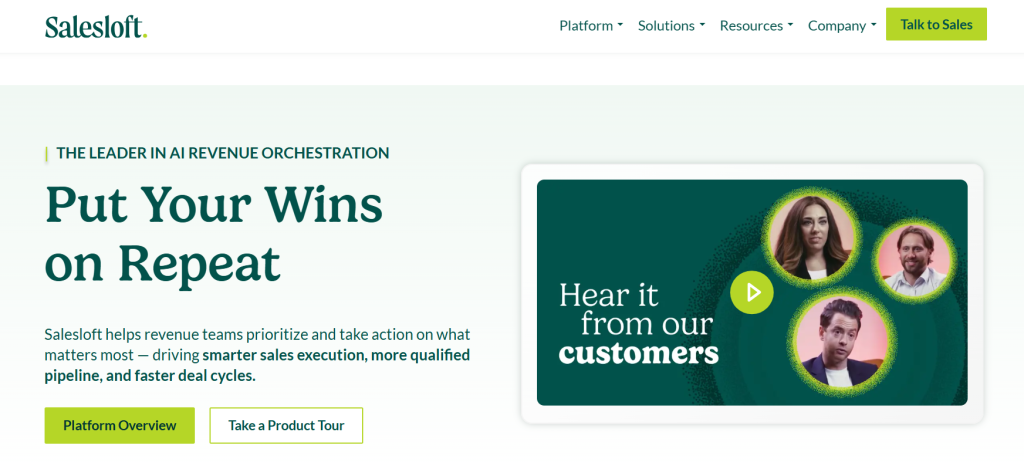
Salesloft is a premier sales engagement platform focused on the entire sales workflow, from prospecting to closing and coaching, with strong conversation intelligence capabilities.
Features:
- Cadences and automated outreach sequences
- Conversation intelligence and call analysis
- Revenue forecasting and pipeline management
- Coaching tools and performance analytics
- CRM integration and data synchronization
What I like about Salesloft:
Salesloft’s strength lies in its coaching capabilities the platform doesn’t just execute outreach, it helps sales reps get better at it. The conversation intelligence provides specific, actionable feedback that managers can use for coaching. I appreciate how they’ve built analytics that focus on improving rep performance rather than just tracking activity metrics.
Pros:
- Strong conversation intelligence capabilities
- Excellent coaching and training features
- Good analytics and reporting
- Comprehensive sales workflow management
Cons:
- Expensive pricing structure
- Requires training for full adoption
- Complex for smaller teams
Pricing: Custom pricing, typically starts around $75-100/user/month
Best for: Mid-market to enterprise sales teams focused on conversation intelligence and coaching
Picreel
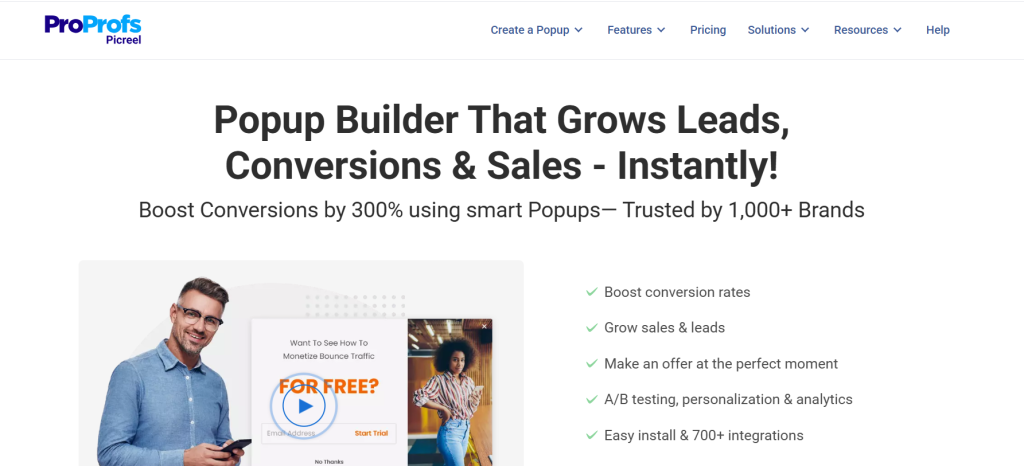
Picreel is an exit-intent popup tool that allows you to generate high-quality leads in an organic manner. As many online shoppers visit your website, Picreel helps you display AI-powered delightful popups to your visitors.
Features:
- Exit-intent popups and lead capture
- 100+ high-converting templates
- A/B testing and optimization
- Advanced targeting and segmentation
- 700+ integrations with CRM and marketing tools
What I like about Picreel:
Picreel’s exit-intent technology is genuinely effective at capturing visitors who would otherwise leave without converting. From my experience with lead generation, timing is everything, and Picreel’s ability to detect when someone is about to leave and present a compelling offer can significantly improve conversion rates. The template library saves considerable design time.
Pros:
- Easy setup and implementation
- Good template library
- Affordable pricing
- Extensive integration options
Cons:
- Limited to website lead capture
- Can impact user experience if overused
- Basic analytics compared to full platforms
Pricing: Plans start at $14/month
Best for: E-commerce and SaaS companies looking to capture website visitors before they leave
With a library of 100+ high-converting pop-up templates, you can easily get started with Picreel in minutes. You can target your new and engaged visitors to promote your products/services, offer deals/discounts, reduce cart abandonment and bounce rates, guide visitors, and generate leads. With an intuitive dashboard, advanced trigger options, analytics, and A/B testing features, Picreel is a great tool for lead generation.
The tool also offers 700+ integrations to automatically transfer captured leads in real time to your sales/marketing/CRM tools.
EmailAnalytics
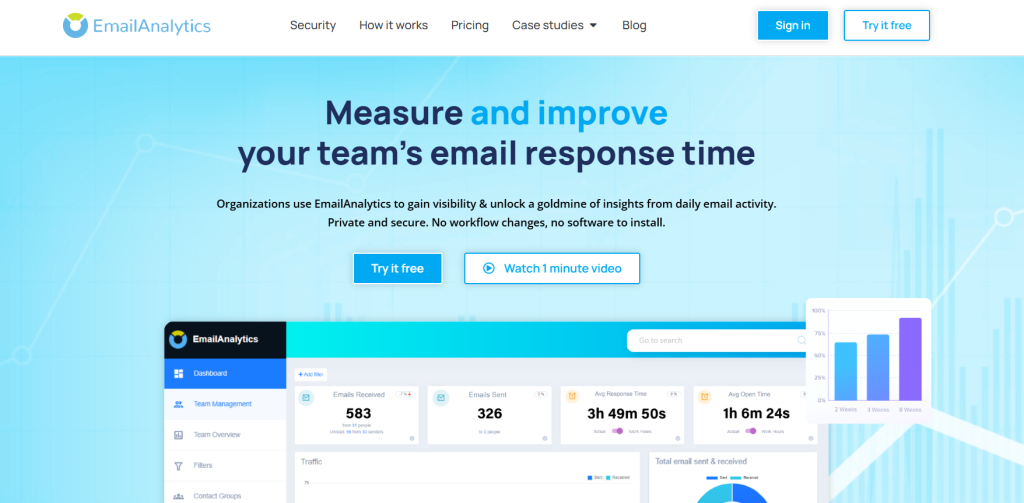
EmailAnalytics is a tool that visualizes your email activity and that of your team or employees. This enables sales teams, customer service teams, and small business owners to measure essential productivity metrics like average email response time, email traffic by the hour of the day, email traffic volume by day of the week, and much more.
Features:
- Email activity visualization and tracking
- Response time monitoring and optimization
- Team performance analytics
- Productivity metrics and reporting
- Email volume and pattern analysis
What I like about EmailAnalytics:
EmailAnalytics provides insights that most sales managers need but rarely get. Understanding email response patterns can reveal productivity bottlenecks and help optimize team performance. I appreciate how it quantifies something as subjective as email productivity, giving managers concrete data to work with for coaching and process improvement.
Pros:
- Affordable pricing
- Easy setup and implementation
- Valuable insights into email productivity
- Good for team management
Cons:
- Limited to email analytics only
- Doesn’t include other communication channels
- Basic feature set
Pricing: Plans start at $5/user/month
Best for: Sales managers looking to optimize team email performance and response times
For lead generation, you can use it to monitor and optimize your sales team’s email outreach efforts and find (and improve) each sales agent’s average email response time, a critical KPI for converting leads.
Conversation Intelligence & AI Assistants
Conversation intelligence tools use AI to analyze sales calls, emails, and meetings to provide coaching insights, deal intelligence, and automated summaries.
Gong.io
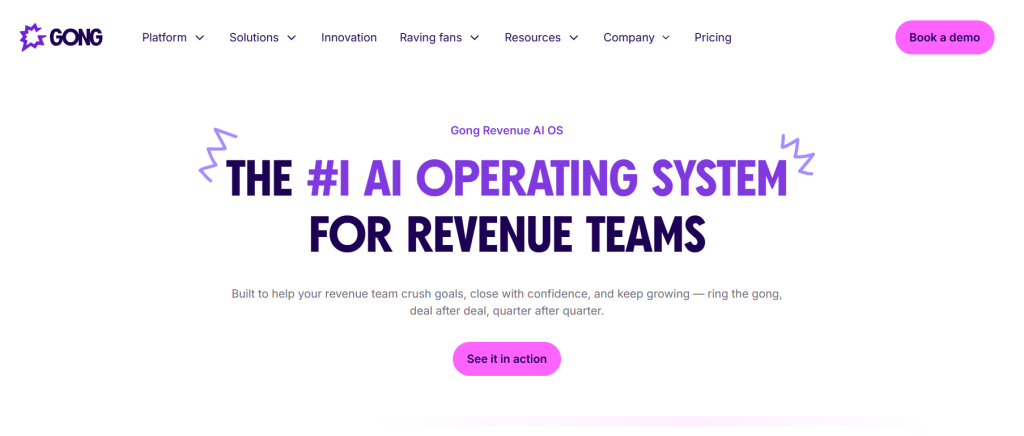
Gong.io is a conversation intelligence platform that uses AI to analyze customer-facing interactions across calls, emails, and meetings to provide data-driven coaching and deal insights.
Features:
- Call recording and automated transcription
- AI-driven conversation insights and analysis
- Deal intelligence and risk assessment
- Coaching recommendations and performance tracking
- Revenue forecasting and pipeline analysis
What I like about Gong.io:
Gong’s AI analysis goes beyond simple call recording it identifies patterns that even experienced sales managers might miss. The platform can detect when deals are at risk based on conversation sentiment and buyer engagement patterns. I’m impressed by how it provides specific, actionable coaching recommendations rather than just generic insights. It’s like having a sales coach that never sleeps.
Pros:
- Market-leading conversation intelligence
- Powerful AI insights and analytics
- Excellent coaching and training features
- Comprehensive deal intelligence
Cons:
- Expensive pricing structure
- Requires significant data to be most effective
- Complex implementation process
Pricing: Custom pricing, typically starts around $120/user/month
Best for: Sales teams focused on improving conversation quality and deal outcomes through AI-driven insights
Fireflies.ai
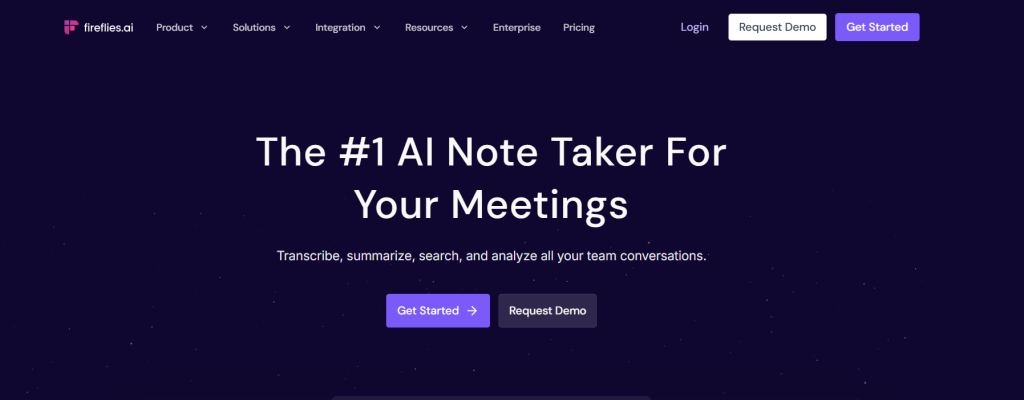
Fireflies.ai is an AI meeting assistant that records, transcribes, and summarizes sales calls, automatically extracting key action items and insights to save reps administrative time.
Features:
- Automated transcription and meeting notes
- AI-powered summaries and action items
- Action item detection and tracking
- CRM integration and data sync
- Searchable call library and analytics
What I like about Fireflies.ai:
Fireflies.ai solves a real productivity problem the time spent on post-meeting administrative tasks. The automatic action item detection is surprisingly accurate, and the searchable call library becomes invaluable for deal reviews and onboarding new team members. For the price point, it delivers exceptional value, especially for teams just starting with conversation intelligence.
Pros:
- Affordable pricing with good free tier
- Easy setup and implementation
- Integrates with popular video platforms
- Saves time on administrative tasks
Cons:
- Less advanced analytics than premium tools
- Limited conversation intelligence features
- Basic coaching capabilities
Pricing: Free plan available. Paid plans start at $10/user/month
Best for: Sales teams looking for automated meeting notes and action item tracking
Email & Outreach Optimization
Email optimization tools use AI to help sales reps write better emails faster, improving response rates and engagement with prospects.
Lavender
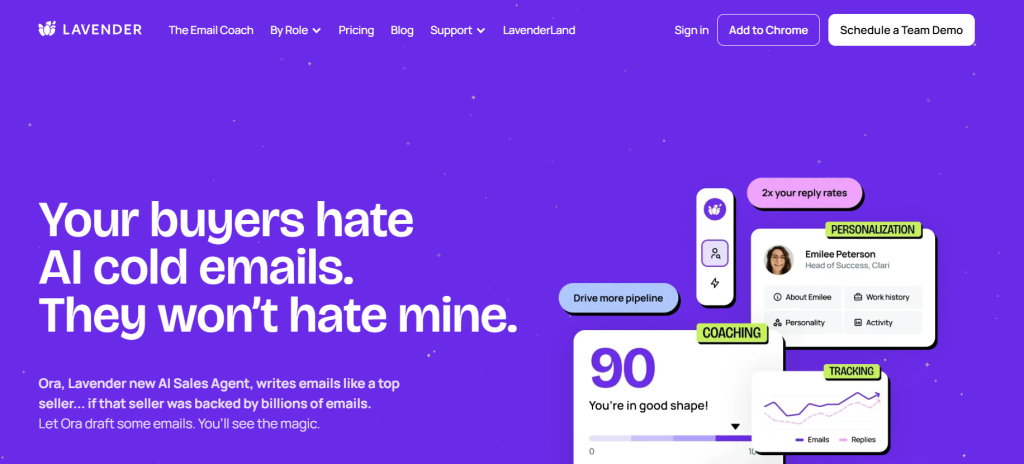
Lavender is an AI-powered email assistant that helps sales reps write better emails faster by providing real-time coaching and personalization suggestions.
Features:
- Real-time email coaching and feedback
- Personalization suggestions and templates
- Sentiment analysis and tone optimization
- Mobile optimization and preview
- Integration with popular email platforms
What I like about Lavender:
Lavender’s real-time feedback is like having an email coach looking over your shoulder. The mobile preview feature is particularly valuable since most prospects read emails on their phones. I appreciate how it focuses on practical improvements shorter sentences, better subject lines, clearer calls-to-action rather than just generic writing advice.
Pros:
- Easy to use with immediate feedback
- Integrates with popular email tools
- Helps improve email response rates
- Good free tier available
Cons:
- Limited to email optimization only
- Requires consistent use to see benefits
- May not work for all writing styles
Pricing: Free plan available. Paid plans start at $25/user/month
Best for: Sales reps looking to improve email response rates and writing efficiency
Scheduling & Meeting Automation
Meeting scheduling tools eliminate the back-and-forth of booking appointments, automatically handling availability, time zones, and calendar integration.
Calendly
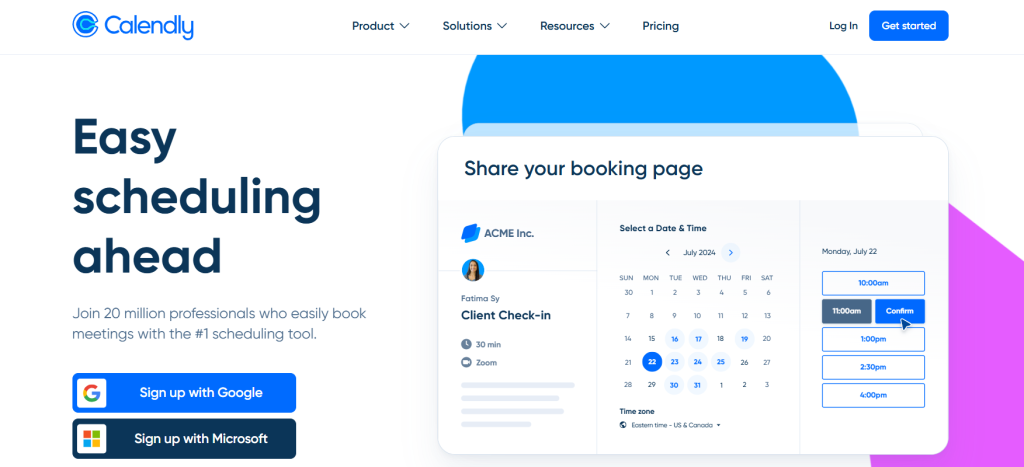
Calendly is one of the best scheduling tools on the market. You can pick an open time slot and book a meeting in just that. The interface is user-friendly, and it has the best calendar integration features and timing controls. You can also utilize time-zone intelligence.
Features:
- Calendar integration and availability management
- Time-zone intelligence and automatic conversion
- Automated reminders and follow-ups
- Custom booking pages and branding
- Payment collection and meeting prep
What I like about Calendly:
Calendly’s simplicity is its strength it just works without complexity. The time-zone intelligence prevents the common scheduling mistakes that can damage professional relationships. I particularly appreciate how it integrates seamlessly with video conferencing tools, creating a smooth experience for prospects. The free tier is genuinely useful, not just a teaser.
Pros:
- Easy to use and set up
- Great free tier with essential features
- Excellent calendar integrations
- Professional booking experience
Cons:
- Limited team features on lower plans
- Fewer advanced routing options
- Basic analytics and reporting
Pricing: Free plan available. Paid plans start at $8/user/month
Best for: Individual sales reps and small teams needing simple, effective scheduling
Calendly is easy to integrate, has a variety of apps, and grows well with your sales team.
Chili Piper
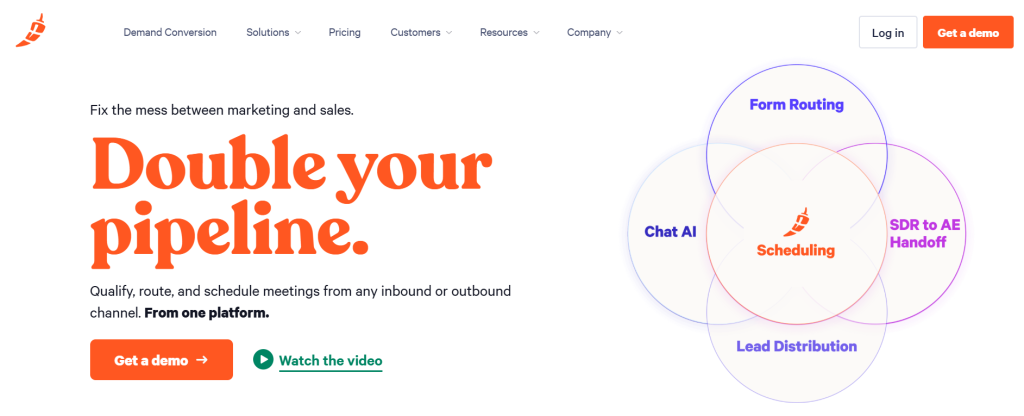
Chili Piper is an advanced scheduling and inbound lead routing tool that instantly qualifies and routes leads to the right sales rep while automating the booking process.
Features:
- Instant Booker for immediate meeting scheduling
- Form Concierge for lead qualification
- Intelligent lead routing and assignment
- CRM integration and data synchronization
- Meeting analytics and performance tracking
What I like about Chili Piper:
Chili Piper’s instant booking capability can dramatically improve conversion rates by eliminating the delay between interest and meeting. The lead routing intelligence ensures prospects connect with the right rep based on territory, expertise, or availability. For inbound-heavy sales teams, this can be a game-changer in terms of speed-to-lead and conversion optimization.
Pros:
- Advanced routing capabilities
- Excellent for inbound lead management
- Strong analytics and reporting
- Reduces lead response time
Cons:
- More expensive than simple schedulers
- Complex setup and configuration
- May be overkill for basic scheduling needs
Pricing: Custom pricing, typically starts around $30/user/month
Best for: Inbound sales teams and RevOps teams needing advanced lead routing and qualification
Squarespace Scheduling (formerly AcuityScheduling)

Squarespace Scheduling is like a digital personal assistant with automated bookings and meeting reminders. The company offers four types of plans; the first one is free. The tool has an easy-to-use interface that can be integrated into multiple platforms.
Features:
- Automated bookings and scheduling
- Payment processing and invoicing
- Client management and communication
- Calendar sync and availability management
- Customizable booking pages and forms
What I like about Squarespace Scheduling:
Squarespace Scheduling excels for service-based businesses that need to collect payments at booking time. The integration with Squarespace websites creates a seamless experience for prospects. I appreciate the comprehensive client management features that go beyond simple scheduling to include intake forms and follow-up communications.
Pros:
- Good for service-based businesses
- Integrated payment processing
- Reasonable pricing structure
- Comprehensive client management
Cons:
- Less focused on sales use cases
- Fewer CRM integrations
- Limited team collaboration features
Pricing: Plans start at $14/month
Best for: Service-based businesses and consultants needing appointment scheduling
Video Conferencing & Communication
Video conferencing tools enable face-to-face interactions with prospects and customers, essential for building relationships and conducting effective sales presentations.
Google Meet

With Google Meet, up to 1,000 participants can make calls from any browser (depending on your Google Workspace plan). The tool offers excellent integration with all of Google’s other apps. A meeting-creation feature activates a Meet link that allows meeting attendees to instantly join a call, share files from Google Drive and apps, and share them on chats without leaving the call.
Features:
- Up to 1,000 participants per meeting
- Meeting recordings and transcriptions
- Breakout rooms and collaboration tools
- Noise cancellation and AI features
- Live streaming and broadcasting
What I like about Google Meet:
Google Meet’s integration with the Google ecosystem is seamless you can start a meeting directly from Gmail or Calendar without switching platforms. The AI-powered noise cancellation works remarkably well, which is crucial for professional sales calls. I appreciate how it handles large meetings without performance issues, making it suitable for team presentations and demos.
Pros:
- Seamless Google Workspace integration
- Reliable performance and quality
- AI-powered features and enhancements
- Good security and privacy controls
Cons:
- Advanced features require paid plans
- Less specialized for sales use cases
- Limited customization options
Pricing: Free version available. Business plans start at $7/user/month
Best for: Teams already using Google Workspace looking for integrated video conferencing
Zoom
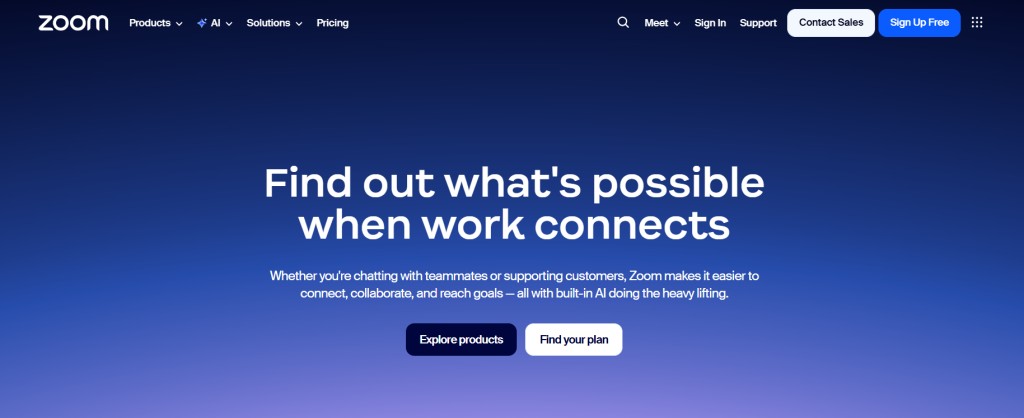
Zoom provides cloud conferencing and software that combines online meetings, video conferencing, and mobile and chat collaboration on multiple platforms. Major companies like GoDaddy, Slack, and Uber use this user-friendly tool in the healthcare, education, finance, and government sectors.
Features:
- HD video and audio quality
- Meeting recordings and cloud storage
- Screen sharing and annotation tools
- Breakout rooms and collaboration features
- Virtual backgrounds and filters
What I like about Zoom:
Zoom’s reliability is unmatched it consistently delivers high-quality video and audio even with poor internet connections. The recording capabilities are essential for sales teams, allowing for call reviews and training. I particularly value the annotation tools during screen sharing, which make product demos more interactive and engaging for prospects.
Pros:
- Excellent reliability and performance
- Comprehensive feature set
- Good mobile app experience
- Strong recording capabilities
Cons:
- Can be expensive for large teams
- Security concerns in the past
- Limited free plan features
Pricing: Free plan available. Paid plans start at $14.99/month/license
Best for: Sales teams needing reliable, feature-rich video conferencing with recording capabilities
Communication & Dialers
Dialer and communication tools streamline phone-based outreach and improve team collaboration around deals and customer interactions.
Aircall
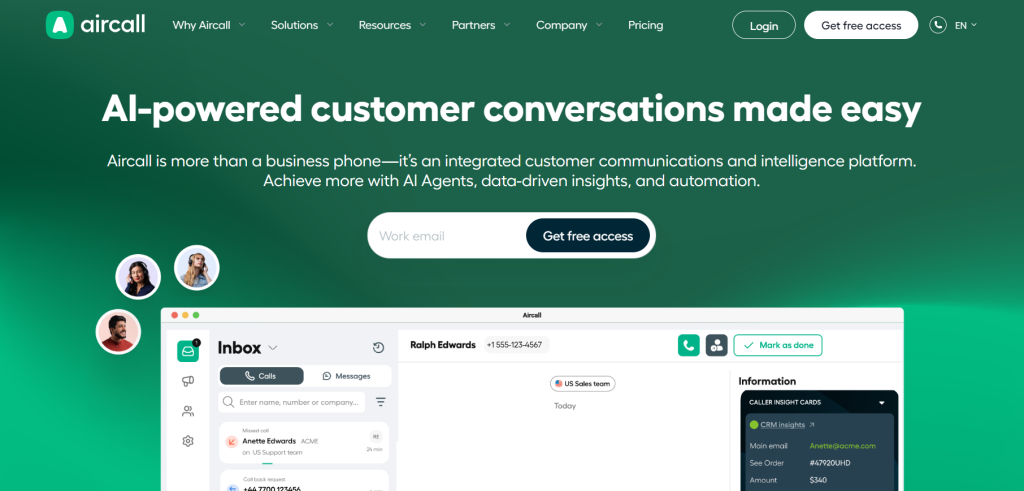
Aircall is one of the finest dialer solutions available. This tool features instant toll-free numbers, information about business hours, call routing, international numbers, call conferencing, and interactive voice response (IVR). It can also create extensions, a virtual call center, and call-blocking features.
Features:
- Cloud-based dialer and phone system
- Call routing and IVR capabilities
- Call recording and monitoring
- CRM integration and data sync
- Analytics and performance tracking
What I like about Aircall:
Aircall’s cloud-based approach eliminates the complexity of traditional phone systems while providing enterprise-level features. The CRM integrations are particularly well-executed call data flows seamlessly into your sales records. I appreciate how it handles international calling without the usual complications, making it ideal for global sales teams.
Pros:
- Easy setup and implementation
- Good CRM integrations
- Comprehensive call management features
- Reliable cloud infrastructure
Cons:
- Can be expensive for large teams
- Limited offline capabilities
- May require additional training
Pricing: Plans start at $30/user/month
Best for: Sales teams needing a cloud-based phone system with CRM integration
Cloudtalk
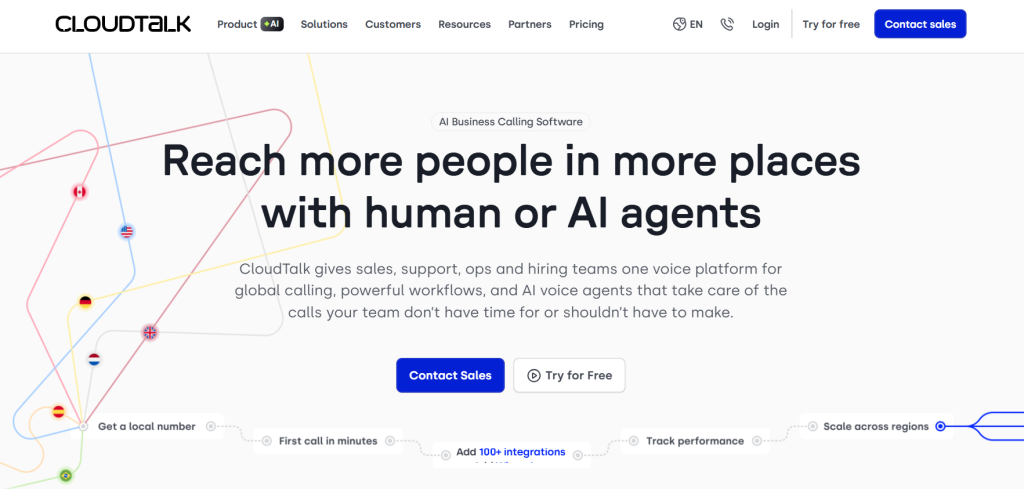
Cloudtalk offers many features, such as call recording, call routing, international numbers (including tags), toll-free numbers, short numbers, call-back features, and customized business hours. You also get advanced features that integrate with both business and sales tools. It also monitors statistics and communications, including utilities and a call center. Alternatively, you can also check out other cloud-based phone system providers, such as ULTATEL.
Features:
- Call recording and quality monitoring
- International numbers and routing
- Business hours customization
- Analytics and reporting dashboard
- Integration with business tools
What I like about Cloudtalk:
Cloudtalk offers solid value for European-based sales teams, with strong local number support and competitive pricing. The analytics dashboard provides useful insights into call patterns and team performance. While not as feature-rich as some competitors, it covers the essentials well and offers reliable service for teams focused on phone-based outreach.
Pros:
- Strong European presence and support
- Comprehensive feature set
- Good analytics and reporting
- Competitive pricing
Cons:
- Less known in US market
- Fewer integrations than competitors
- Limited advanced features
Pricing: Plans start at €20/user/month
Best for: European sales teams needing a comprehensive cloud phone solution
Slack
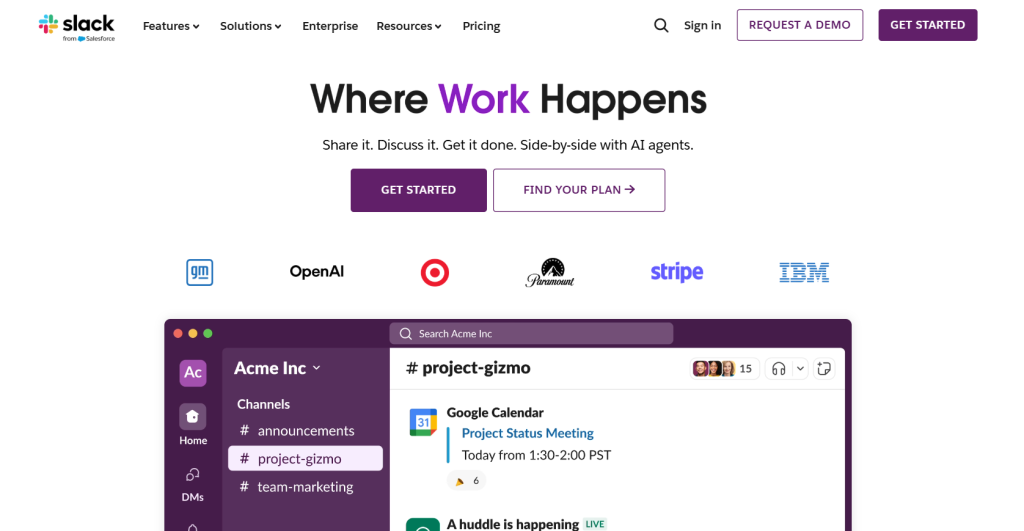
Slack is a channel-based messaging platform for team communication and collaboration that increases internal productivity by centralizing communication about deals, customers, and strategy.
Features:
- Channel-based messaging and organization
- File sharing and document collaboration
- App integrations and workflow automation
- Voice and video calls
- Search and knowledge management
What I like about Slack:
Slack transforms team communication by organizing conversations around specific deals, accounts, or projects. The integration ecosystem is impressive you can get notifications from your CRM, scheduling tools, and other sales apps directly in Slack. I particularly value how it creates transparency around deal progression and enables quick collaboration without email chains.
Pros:
- Excellent for team collaboration
- Extensive app integrations
- Reduces email clutter
- Good mobile experience
Cons:
- Can become noisy with too many channels
- Requires team adoption for effectiveness
- Can be distracting if not managed well
Pricing: Free plan available. Paid plans start at $7.25/user/month
Best for: Collaborative sales teams needing real-time communication and deal coordination
Proposal & eSignature Tools
Proposal and eSignature tools help sales teams create professional proposals, track engagement, and close deals faster with electronic signatures.
PandaDoc
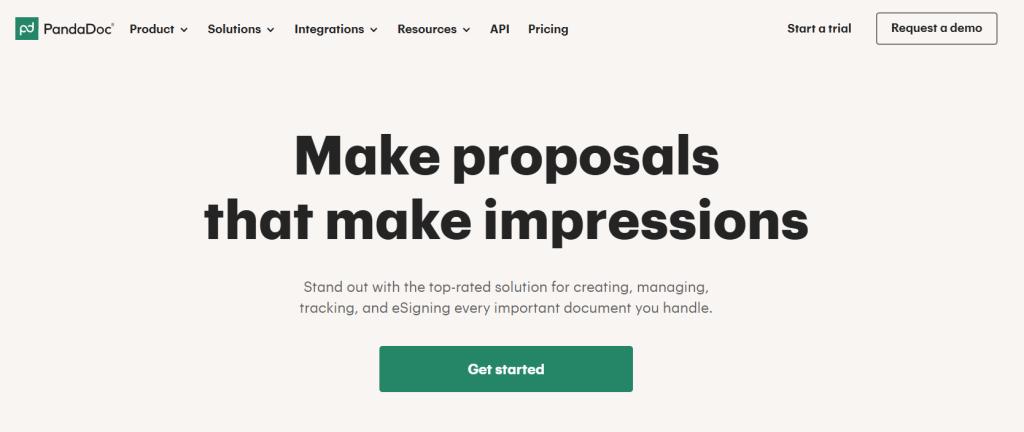
PandaDoc is a leading document automation software for creating, sending, and tracking proposals, quotes, and contracts with built-in eSignature capabilities.
Features:
- Template library and document creation
- eSignatures and approval workflows
- Document analytics and tracking
- CRM integration and automation
- Payment processing and collection
What I like about PandaDoc:
PandaDoc’s document analytics are incredibly valuable you can see exactly how prospects engage with your proposals, which sections they spend time on, and when they share documents internally. This intelligence helps sales reps time their follow-ups perfectly and address specific concerns. The template library saves significant time while maintaining professional consistency.
Pros:
- Comprehensive template library
- Good analytics and engagement tracking
- Integrated payment processing
- Strong automation capabilities
Cons:
- Can be complex for simple use cases
- Pricing increases with advanced features
- Learning curve for full utilization
Pricing: Free eSign plan available. Paid plans start at $19/user/month
Best for: Sales teams needing comprehensive document automation with templates and analytics
Proposify
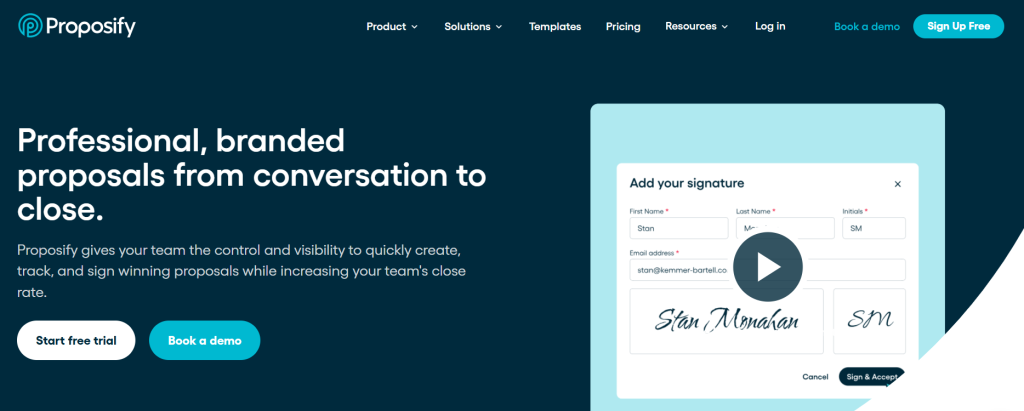
Proposify helps you create improved business proposals online through interactive quotations, metric measurements, notifications, eSignatures, content libraries, customizable fields, and variables. It allows for the addition of videos, is available in multiple languages, and has comment and chat features.
Features:
- Interactive proposals and presentations
- Content libraries and template management
- eSignatures and approval tracking
- Proposal analytics and engagement metrics
- Team collaboration and commenting
What I like about Proposify:
Proposify’s interactive elements set it apart from traditional proposal tools. The ability to embed videos, interactive pricing calculators, and multimedia content creates engaging experiences that prospects remember. I appreciate how it focuses specifically on proposals rather than trying to be a general document platform, resulting in features that truly serve sales teams.
Pros:
- Beautiful, interactive proposal templates
- Good collaboration features
- Interactive elements and multimedia support
- Strong analytics and tracking
Cons:
- Higher price point than competitors
- Focused primarily on proposals rather than full document management
- Limited integration options
Pricing: Plans start at $49/user/month
Best for: Sales teams focused on creating visually appealing, interactive proposals
Signaturely
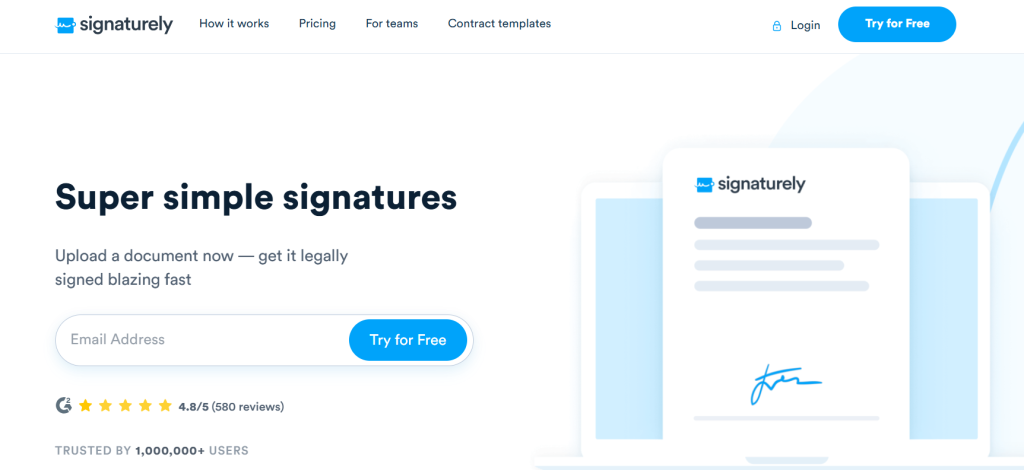
Signaturely is a free e-signature solution to get legally binding online signatures on forms, proposals, and agreements online.
Features:
- Legally binding eSignatures
- Document templates and customization
- Team management and user roles
- Audit trails and compliance
- Mobile app and offline access
What I like about Signaturely:
Signaturely’s strength is its simplicity and affordability. For small businesses that need basic eSignature functionality without complex workflows, it delivers exactly what’s needed. The free tier is genuinely useful for low-volume needs, and the paid plans remain affordable as you scale. The mobile experience is particularly well-designed.
Pros:
- Affordable pricing with free tier
- Simple, intuitive interface
- Good free tier for basic needs
- Fast document processing
Cons:
- Limited advanced features
- Fewer integrations than enterprise solutions
- Basic analytics and reporting
Pricing: Free plan available. Paid plans start at $20/month
Best for: Small businesses and startups needing simple, affordable eSignature capabilities
Signaturely’s simple interface allows you to add a space for a signature by uploading your proposal and adding the space for the signature online. Then, you send it to the relevant parties through the platform to get signed.
All of the signatures collected by Signaturely are legally binding.
DocuSign
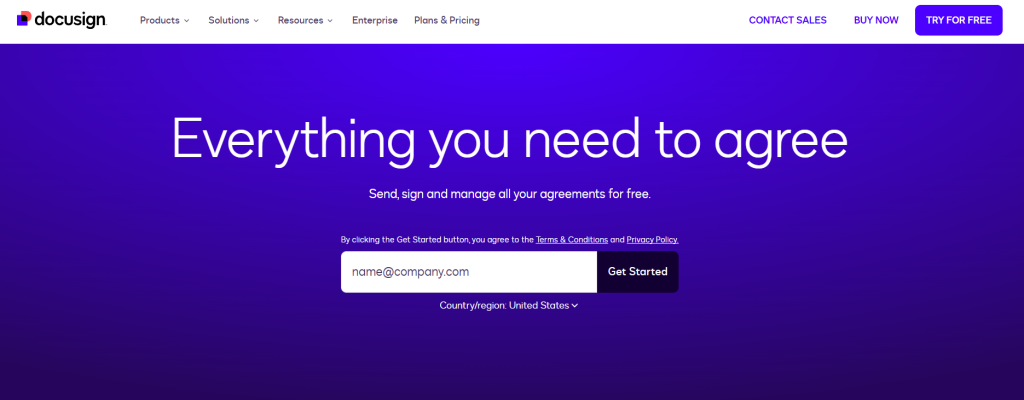
DocuSign helps with the creation of both online proposals and eSignature features. This tool is fast, and it helps with quick document signing. You can easily integrate DocuSign with other apps, and it has more than 200 million users around the globe.
Features:
- Advanced eSignatures and digital identity
- Document workflow automation
- Compliance features and audit trails
- Extensive integrations and API access
- Mobile app and offline capabilities
What I like about DocuSign:
DocuSign’s market leadership comes from its reliability and comprehensive feature set. The compliance capabilities are enterprise-grade, making it suitable for regulated industries. I appreciate the extensive integration ecosystem DocuSign works with virtually every business tool you might use. The brand recognition also helps with prospect adoption since most people are familiar with the platform.
Pros:
- Industry leader with proven reliability
- Comprehensive features and capabilities
- Strong compliance and security
- Extensive integration ecosystem
Cons:
- Can be expensive for small teams
- Complex for simple use cases
- May require training for full utilization
Pricing: Plans start at $15/user/month
Best for: Enterprise sales teams needing comprehensive document management and compliance features
DocuSign allows people to sign documents anywhere and has reliable cloud access for document storage.
Dropbox Sign (formerly HelloSign)
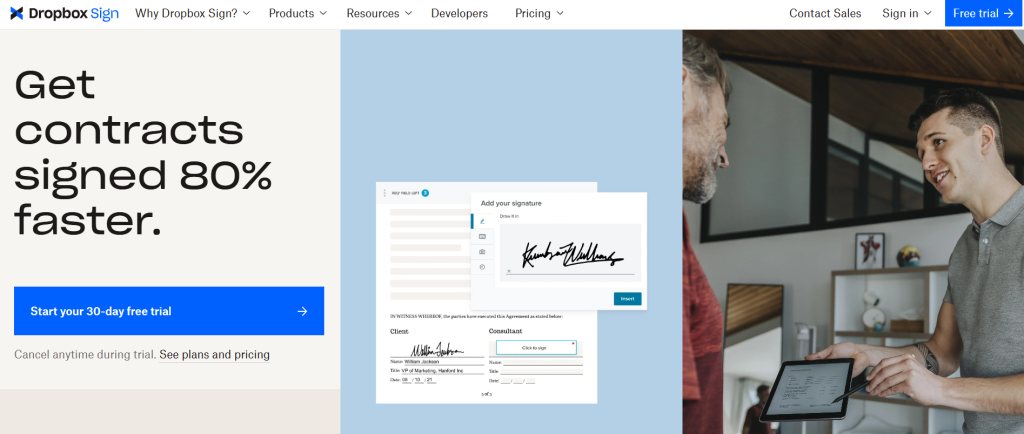
Dropbox Sign has flexible workflow processes that easily facilitate the crafting and signing of proposals. It’s user-friendly, offers easy signature features, and cloud storage. Proposals created on other apps can also be easily amended on this platform, along with convenient API features.
Features:
- eSignatures and document workflows
- Dropbox integration and file management
- Template management and reuse
- API access and custom integrations
- Workflow automation and notifications
What I like about Dropbox Sign:
Dropbox Sign’s integration with the Dropbox ecosystem creates a seamless file management experience. For teams already using Dropbox for storage, this eliminates the friction of moving documents between platforms. The API is well-documented and developer-friendly, making custom integrations straightforward for technical teams.
Pros:
- Seamless Dropbox integration
- User-friendly interface
- Good API and developer tools
- Reliable performance
Cons:
- More expensive than some alternatives
- Limited advanced features compared to enterprise solutions
- Requires Dropbox ecosystem for full benefits
Pricing: Plans start at $15/user/month
Best for: Teams already using Dropbox ecosystem needing integrated eSignature capabilities
Sales Enablement & Content Management
Sales enablement platforms help sales teams access, manage, and track the effectiveness of sales content, training materials, and best practices.
Highspot
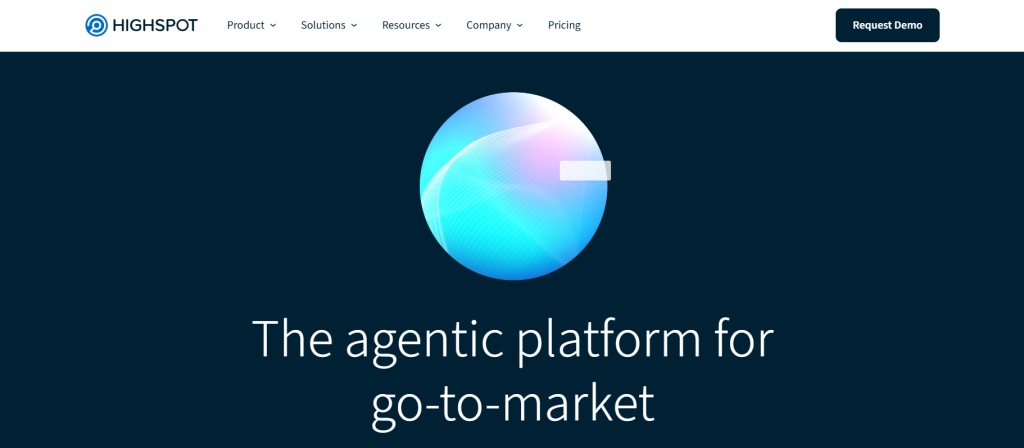
Highspot is a leading sales enablement platform for managing, sharing, and tracking sales content with advanced analytics and coaching capabilities.
Features:
- SmartPitches and content personalization
- Content scoring and effectiveness tracking
- Training and coaching tools
- Analytics and performance insights
- CRM integration and workflow automation
What I like about Highspot:
Highspot’s content analytics are game-changing you can finally measure which sales materials actually drive results. The SmartPitches feature helps reps deliver consistent, on-brand presentations while still allowing for personalization. I appreciate how it bridges the gap between marketing-created content and sales execution, ensuring materials are actually used and effective.
Pros:
- Comprehensive sales enablement platform
- Excellent analytics and content tracking
- Strong coaching and training features
- Good integration capabilities
Cons:
- Expensive pricing for small teams
- Complex implementation process
- May be overkill for simple content needs
Pricing: Custom pricing, typically starts around $50/user/month
Best for: Enterprise and mid-market sales teams needing comprehensive content management and training
Productivity & Time Management
Productivity tools help sales teams track time, manage workflows, and optimize their daily activities for maximum efficiency.
TMetric
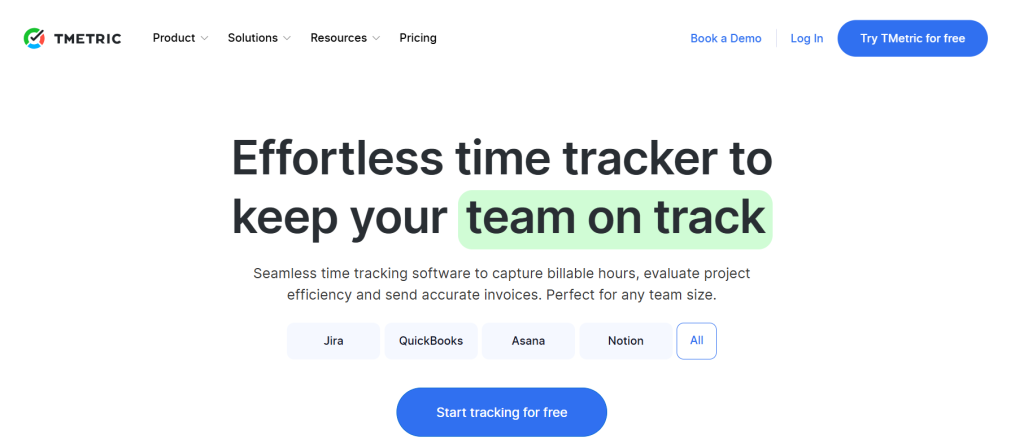
With features that go beyond basic time tracking, TMetric is a productivity tool and time tracker that is easy to use and intuitive enough to support sales teams of any size. It simplifies reporting, invoicing, and time and workforce management, enabling sales teams to work as productively as possible.
Features:
- Time tracking and project management
- Invoicing and billing automation
- Team management and collaboration
- Productivity reports and analytics
- Integration with popular business tools
What I like about TMetric:
TMetric provides the detailed insights that sales managers need to optimize team performance. The ability to track time across different activities helps identify where reps are spending too much time on non-selling activities. I appreciate how it balances comprehensive tracking with ease of use team members don’t feel burdened by the tracking process.
Pros:
- Comprehensive time tracking capabilities
- Good reporting and analytics
- Affordable pricing structure
- Easy to use interface
Cons:
- May be too detailed for simple use cases
- Requires consistent use for maximum value
- Limited advanced project management features
Pricing: Free plan available. Paid plans start at $5/user/month
Best for: Sales teams needing detailed time tracking and productivity analysis
Traqq
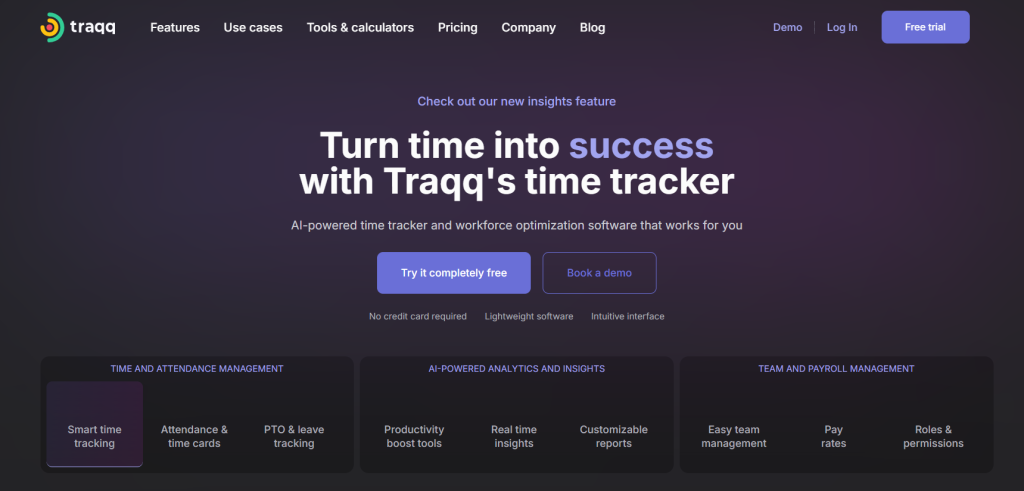
Traqq combines robust time tracking with app and website monitoring to give teams clear insights into their productivity. Its customizable reports, individual pay rates, and team management features make it adaptable for any workflow, empowering sales teams to stay on top of sales targets. Built for flexibility, Traqq supports both online and offline tracking, allowing teams to track time seamlessly.
Features:
- Time tracking with app and website monitoring
- Productivity insights and analytics
- Team management and oversight tools
- Offline tracking capabilities
- Customizable reports and pay rates
What I like about Traqq:
Traqq’s monitoring capabilities provide valuable insights into how sales teams actually spend their time versus how they think they spend it. The offline tracking is particularly useful for field sales teams. While the monitoring features require careful implementation to maintain team trust, the productivity insights can be invaluable for identifying optimization opportunities.
Pros:
- Detailed monitoring capabilities
- Flexible tracking options
- Competitive pricing
- Good team oversight features
Cons:
- May feel invasive to some team members
- Requires setup for optimal use
- Limited integration options
Pricing: Plans start at $4/user/month
Best for: Sales managers needing detailed productivity monitoring and team oversight
How to Choose the Right Sales Productivity Tools
Selecting the right sales productivity software requires a strategic approach. Follow this step-by-step guide to make the best decision for your team:
Step 1: Identify Pain Points and Needs
Before looking at any software, analyze your current sales process and identify specific bottlenecks. Involve your sales team to understand their daily challenges, such as excessive manual data entry, difficulty tracking leads, or inefficient outreach. Document these pain points as they will guide your tool selection.
Step 2: Define Key Features and Goals
Based on your pain points, create a list of must-have features. For example, if lead management is a struggle, you need strong CRM and pipeline management features. Align these features with measurable goals, like ‘reduce data entry time by 20%’ or ‘increase lead conversion rate by 15%’.
Step 3: Research and Shortlist Vendors
Scan review sites, read case studies, and ask peers for recommendations to create a longlist of potential tools. Narrow this down to 2-4 vendors that best match your feature requirements and budget.
Step 4: Evaluate Integrations, Scalability, and Usability
A crucial criterion is how well a new tool integrates with your existing tech stack (e.g., your CRM, email). Poor integration creates data silos and inefficient workflows. Assess if the tool can scale with your business as your team and data volume grow. The user interface must be intuitive; if reps find it hard to use, adoption will fail.
Step 5: Conduct Demos and Free Trials
Never commit without a trial. Use this period to have your sales team test the software in a real-world setting. Pay attention to how quickly they can learn the system and whether it actually solves your identified pain points.
Step 6: Analyze ROI and Check Support
Evaluate the total cost of ownership, including subscription, implementation, and training fees. Compare this against the expected return on investment from efficiency gains and increased revenue. Also, verify the quality of vendor customer support, as responsive help is critical for long-term success.
Frequently Asked Questions
What are the best sales productivity tools for small businesses?
For small businesses, the best tools are often scalable, affordable, and solve specific problems without requiring a large IT team. Key recommendations include HubSpot Sales Hub offering a free-forever plan with CRM, email tracking, pipeline management, and meeting scheduling. Pipedrive provides visual pipeline management helping small teams track deals effectively. Calendly eliminates back-and-forth booking by allowing prospects to schedule directly.
How is AI changing sales productivity?
AI is revolutionizing sales by automating repetitive tasks and providing data-driven insights. Key impacts include task automation where AI automates CRM updates, data entry, and meeting summaries, saving reps several hours per week. Intelligent lead scoring allows AI to analyze customer data to score and prioritize leads, increasing lead conversion rates by up to 30%. Conversation intelligence through tools like Gong uses AI to record and analyze sales calls, providing coaching insights and deal intelligence.
What are some free sales productivity tools to get started?
Top free options include HubSpot Sales Hub with comprehensive free CRM, Calendly for scheduling automation, Fireflies.ai for transcribing sales calls, and Google Meet for video conferencing. These tools provide substantial value without upfront costs, making them perfect for testing sales productivity improvements.
How do sales tools integrate with existing CRM systems?
Integration methods include native integrations where many tools offer direct connections to popular CRMs like Salesforce and HubSpot. Integration platforms like Zapier and MuleSoft can connect tools that don’t have native integrations. API connections allow custom integrations for specific business needs. Most modern sales tools prioritize CRM integration as a core feature.
Build Your High-Efficiency Sales Stack
The right sales productivity tools can transform your team from administrative assistants into revenue-generating machines. Remember, the goal isn’t to adopt every tool available, but to strategically select the ones that solve your specific challenges and integrate well with your existing processes.
Start with the fundamentals: a solid CRM, reliable communication tools, and basic automation. Then gradually add specialized tools like conversation intelligence, sales enablement, or advanced analytics as your team grows and your needs become more sophisticated.
The 83% of sales teams using AI who saw revenue growth didn’t get there overnight. They built their tech stack thoughtfully, trained their teams properly, and measured results consistently. Your sales productivity transformation starts with the first tool you implement today.

